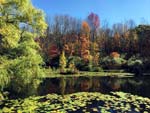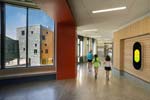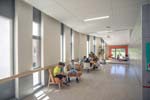
|

|
|
Home Site Search Contact Us Subscribe
|
|
Building Abundance #4: Abundance from Regeneration - Our Opportunity as Designers Design strategies that are driven by an understanding of place, community, and full intentionality can achieve abundance. By Susanne Angarano, ASID, CID, NCIDQ May 23, 2019 Editor’s note: This is the fourth in a series on abundance created and curated by Edward McGraw, AIA, LEED AP BD+C, founding partner and chief executive officer of Ashley McGraw Architects. See previous columns by McGraw, Plaut, and Fedrizzi at the end of this column.
Design has the unique power to transform the natural environment, built space, and human lives. With such power comes responsibility, and the opportunity for architects and designers to contribute to and cultivate an abundant future. For me, this sense of responsibility is rooted in the key principles of regenerative development, and my personal decision to view design as a means to regeneration and transformation.
As defined by CLEAR (Center for Living Environments and Regeneration), “regenerative development is the process of cultivating the capacity and capability in people, communities, and other natural systems to renew, evolve, and thrive.” At Ashley McGraw, we define regenerative development as the process of authentically engaging our clients and stakeholders to explore and realize potential in whole and nested systems. This creates resilient, net-positive, and transformative projects that heal and evolve environmental and social systems.
Regenerative principles position design ideas to ensure a thriving future across communities, ecologies, and individual experiences. What is the potential for each project to create a regenerative legacy? How can this legacy generate and maintain abundance? How can communities participate in regeneration? Working to sustain what exists is no longer enough. We must find capacity, community, and consciousness in our work and in ourselves to cultivate regeneration, and, in turn, abundance. We must act now to bring about change in order to have a viable future.
Intentionality, community, and the future
At the start of a project, we ask, “What do we design for?” and “Whom do we design for?” I have begun to challenge the intention of these questions. Instead, I want to know: What is the place in which we design? Who is affected by and engaged in this work? Can we design for long-term realities rather than for immediate solutions?
To begin to answer these questions, it is vital to facilitate community and stakeholder engagement, to create space for conversations that dig deeper into culture, history, and context. This can be described as building knowledge and therefore capacity, but it’s also about intentionality and awareness. In his 2005 commencement speech at Kenyon College, David Foster Wallace said: “[Your education] isn't really about the capacity to think, but rather about the choice of what to think about,” and “learning how to think really means learning how to exercise some control over how and what you think. It means being conscious and aware enough to choose what you pay attention to, and to choose how you construct meaning from experience.”
Such awareness expands the idea of community, stretching across time, historically and into the future. This mindset, akin to the Seventh Generation approach espoused by the Haudenosaunee and other Native American cultures, expands the place, connecting the community with the immediate and extended environment around any project.
Abundance as the outcome of design
I began this line of thinking while I was a graduate student at Cornell University’s College of Design and Environmental Analysis. Focusing on sustainable design in a research-based program, I found myself in a wonderful center of philosophy – and evidence-based pedagogy. My eyes were opened to the great value of design and its power in the world.
So how can we, as designers, be advocates for and instigators of regeneration? I have come to realize that the nature of this work makes it extremely difficult to define and articulate. By breaking down the elements of this work, and helping others find their own paths, I strive to bring these concepts to the forefront, to help grow the community of regenerative thinkers and designers as a force for positive change.
I suggest that architects and designers have the knowledge, capacity, and tools with which to produce and execute design. I believe that design excellence can be synonymous with regenerative development, and that it is our duty to use our talents as agents for regeneration. Design strategies that are driven by an understanding of place, community, and full intentionality can achieve abundance.
Susanne Angarano, ASID, CID, NCIDQ, is a principal at Ashley McGraw Architects. Her extensive experience includes a focus on higher education projects and holistic sustainable design work. Committed to environmentally sound design, Angarano recognizes the responsibilities of her profession. She is currently heading the interior design team for a research facility at Binghamton University, Nuthatch Hollow, which is targeting Living Building certification. Angarano has presented her work and research at several professional conferences, including the International Living Future Institute unconference, International Living Product Expo, ERAPPA, New York State Green Building Conference, and the New York State Sustainability Conference. Angarano holds a Master of Arts degree in Design: Sustainable Design Studies/Interior Design from Cornell University, and a Bachelor of Fine Arts degree in Interior Design from Syracuse University,
See also:
Building Abundance #3: Abundance in Architecture Starts with Abundance in Human Health Just as buildings became an incredible tool in the movement for environmental sustainability, they can and must become our greatest asset when it comes to human sustainability. By Rick Fedrizzi
Building Abundance #2: Three Keys to Abundant Design Hint: Designing for
less bad won't get us there. Aiming for abundant design requires seeing and
working in new ways that are largely unfamiliar, challenging - but oh so worth
it!
Creating abundance is more than sustainability or resilience, and should be a driving force in architecture. By Edward McGraw, AIA, LEED AP BD+C
|
(click on pictures to enlarge)  Ashley McGraw Architects Google defines abundance as “plentifulness of the good things in life.”  John Griebsch Photography New MacArthur Elementary School, Binghamton, NY: A hallway leading to one of the academic wings. Three two-story classroom wings are raised on columns above the newly established flood plain and related in scale and articulation to the street and adjacent neighborhood.  John Griebsch Photography MacArthur Elementary School: A playscape underneath the raised academic wings.  John Griebsch Photography Development of interior spaces was influenced by student input that “learning takes place everywhere and all the time.” Informal collaborative areas and in-between spaces (third spaces) accommodate ever-evolving pedagogy. |
© 2019 ArchNewsNow.com